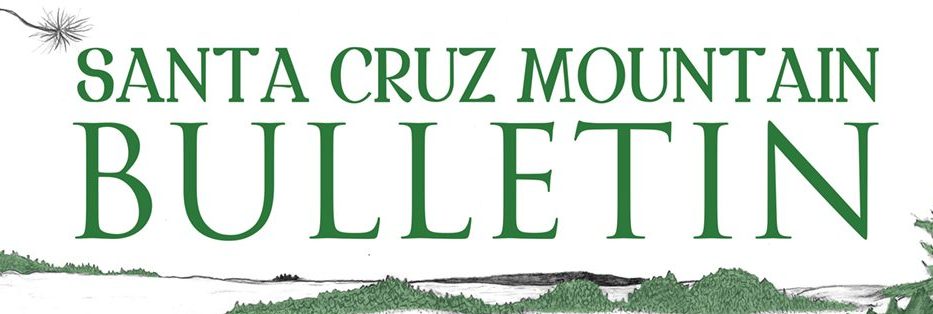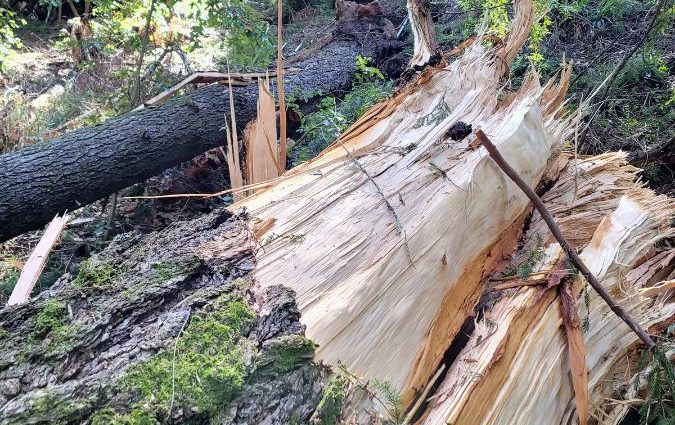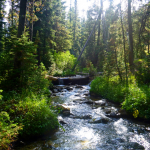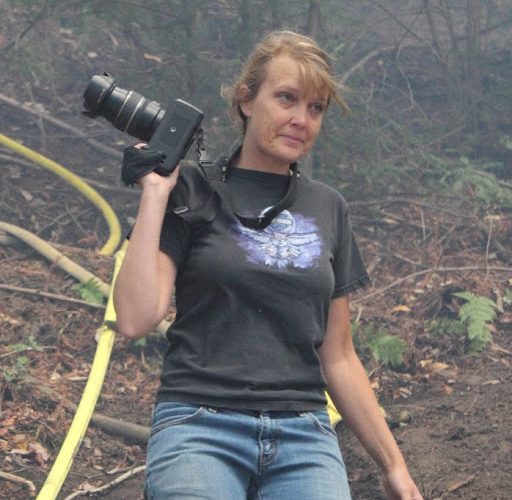Living in Safety and Harmony Amongst Them
By Lori Suzanne Holetz
A lonely nine acre strip of land borders Notley Creek; a steep hillside wedged between Cresta Vista and Juanita Road, this is what’s left of the Juanita Woods land grant, just about a mile north of the town of Boulder Creek proper. Left to remain wildland, and majestic with its many cathedrals of redwood trees, this property is also littered with dangerous fir trees. The property owners live beyond the county and have allowed this land to lie unkempt from its falling debris, in its natural state.
Several individuals have been intruding upon this land, illegally clearcutting trees from its southern perimeter to sell for firewood while removing an important windbreak for the trees still standing. Now they are increasingly vulnerable to these extremely powerful winds we’ve been experiencing. Five massive firs from this parcel came crashing down in this last atmospheric river storm with the 80 mph winds. Two neighboring homes along the Juanita side of the parcel, were near misses as three of the five firs fell. The neighborhood remains terrorized and feeling helpless under these most dangerous circumstances. Communication with the property owner, over the past two and a half years, to cull the hazard trees, has been challenging, in order to produce any safeguard or security for those of us who live here. Out of sight, out of mind, while neighbors continue to live in fear.
It’s an extremely expensive proposition to secure and safeguard the land. No one wants to lay down trees in what’s left of our mountain forests. However, as more and more people come to inhabit, more lands become potential for disaster. What recourse do we have when neighboring parcels become death traps? Where does the Santa Cruz County Department of Environmental and Resource Protection stand on issues of this nature? In a conversation with John Cairnes, the official “tree expert” for the county, he had this to say:
1) The riparian corridor, the area directly alongside a waterway or creek, is 50 feet beyond its banks. Any tree over 50 feet away can be removed without a permit. The top third of any tree can be removed without permit to ensure safety.
2) The county need not and will not become involved in any tree issue on private land unless it falls within the riparian zone.
3) No permits or certified arborist reports are necessary to remove a tree unless it falls within the riparian zone. Arborists reports can run $500 per tree and often a costly, unnecessary expense that could be put towards removal of danger.
4) Landowners are ultimately responsible for all trees upon their parcel and liable for any damage to adjacent parcels done as a result of any falling trees from their parcel.
5) “Heritage” trees are any trees that are bigger than 4 feet across at 4 feet above ground level. However, this only applies to coastal regions. Heritage trees do require a permit and replanting of another tree upon removal.
Know your land. It is critically important, especially with these increasing atmospheric river storms that landowners assess and understand their land. If a property has large trees, especially the firs with their shallow roots, the trees should be assessed for disease like mushroom fungus and/or core rot. This obviously makes the trees much more dangerous and vulnerable to falling. An assessment is as easy as contacting a local tree company and having their experts come out for a look. To quote Bobby Pilgreen of Travis Tree here in Boulder Creek, “Don’t ever let anyone tell you which direction a tree is going to fall!”.
Truer words were never spoken when it comes to an enormous tree coming down. So many factors can lead to life threatening disasters, as we have heard dramatically frightening stories of recently, and we continue to see trees falling across our roads, and some homes. Awareness and action can help to mitigate potential damage, and no one should have to live in constant fear for their lives.
Michelle Deschler, a relatively new neighbor in the Juanita Woods area, described hearing the snap and crack of the three trees that came crashing down around and through her rental home. She and her children ran for their lives, holding her baby in her arms, her other small child in tow, narrowly escaping the crush through her living room.
We all take a risk in choosing to live here in these glorious mountains, with the occasional threats of wind, rain and falling trees. But these threats are becoming more frequent with the changing climate conditions, and thus it becomes increasingly important to assess our own properties to mitigate threats as much as possible. There will always be areas that will remain wild and dangerous. But when we are able, it is important to properly steward the land we take ownership of and properly maintain it, as to avert catastrophic damage as best we can. Knowledge of endangerment without action is negligent liability and can end up costing our very lives.
If you believe you are in danger there is action you can take. It doesn’t cost anything to have a local tree company come out and give an assessment and estimate. It is recommended at least three companies are contacted for comparison. Removal of any tree in our mountains is highly specialized work and it is recommended that the local tree guys are the best for this type of removal. Companies from Watsonville, San Jose area or even Santa Cruz will usually shy away from the difficulties of this type of tree removal. These companies don’t climb the trees but rather use cranes which are impossible to get into the mountainous areas. In speaking with several of these tree companies from the lowlands, they have stated they just can’t compete with the local guys who can climb, tie off and section by section, lay a tree down gently without harm to the surrounding area.
You can contact Santa Cruz County Environmental Planning, Mr. John Cairnes at (831) 454-3548 if you have any questions about hazard trees. You can locate parcel property boundaries via the County’s website at http://www.santa-cruz.ca.us





















